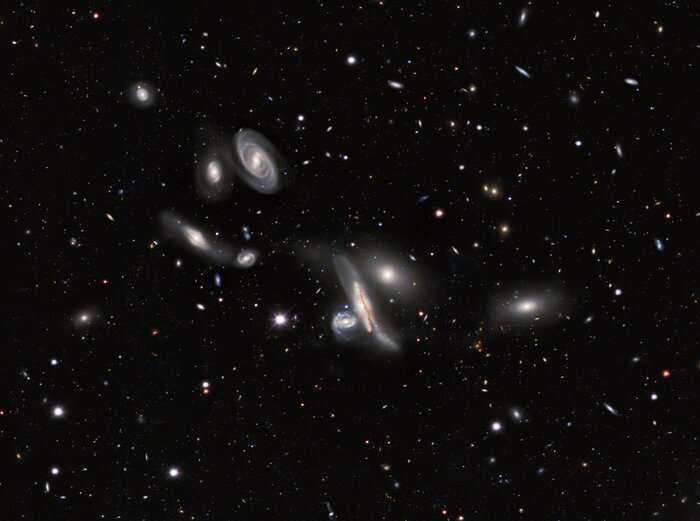Astronomical maps may help explain what this dark energy is and why it exists.
Capitalizing on that possibility requires an unprecedented map—one that charts faint galaxies more uniformly and over a larger area of sky than ever before. To meet that challenge, astronomers have now created a new two-dimensional map of the sky that is the largest ever made in terms of sky coverage, sensitivity, and the total number of galaxies mapped.
From among the more than 1 billion galaxies in the map, astronomers will select tens of millions of galaxies for further study with the Dark Energy Spectroscopic Instrument (DESI), in order to construct the largest 3-D map ever attempted. The results from the DESI survey, which will be carried out at Kitt Peak National Observatory (KPNO), a Program of National Science Foundation's NOIRLab, will ultimately provide new insights into the nature of dark energy.
The new map is the result of the DESI Legacy Imaging Surveys, an ambitious 6-year effort involving 1405 observing nights at three telescopes, years of data from a space telescope, 150 observers and 50 other researchers from around the world, 1 petabyte of data (1000 trillion bytes), and 100 million CPU hours on one of the world's most powerful computers. The images were taken at KPNO and Cerro Tololo Inter-American Observatory (CTIO), also a Program of NOIRLab, and supplemented by images from NASA's Wide-field Infrared Survey Explorer (WISE) mission. The data were reduced at Berkeley Lab's National Energy Research Scientific Computing Center (NERSC).
The map covers half of the sky, digitally sprawling over 10 trillion pixels, which is equivalent to a mosaic of 833,000 high-resolution smartphone photos, and is one of the most uniform, deep surveys of the sky ever undertaken. "This is the biggest map by almost any measure," said David Schlegel, co-project scientist for DESI who also co-led the imaging project. Schlegel is an astrophysicist at the Department of Energy's Lawrence Berkeley National Laboratory (Berkeley Lab), the lead institution for the international DESI collaboration.
Arjun Dey, the DESI Project Scientist for NOIRLab, co-led two of the three imaging surveys, serving as the lead scientist for the Mayall z-band Legacy Survey (MzLS) observed by the Mosaic3 camera on the Nicholas U. Mayall 4-meter Telescope at KPNO, and as co-lead scientist with Schlegel for the Dark Energy Camera Legacy Survey (DECaLS) on DECam on the Víctor M. Blanco 4-meter Telescope at CTIO in Chile.
The third survey is the Beijing-Arizona Sky Survey (BASS) observed by the 90Prime camera on the Bok 2.3-meter Telescope, which is owned and operated by the University of Arizona and located at KPNO.
The collective effort of the three surveys, Dey said, "was one of the most uniform, deep surveys of the sky that has ever been undertaken. It was really exciting to participate."
The DESI collaboration will select 35 million galaxies and 2.4 million quasars in the map—some as far away as 12 billion light-years—as targets for the DESI survey. Over five years of operations, DESI will create a giant 3-D map of the Universe by measuring the galaxies' distances and the rate at which they are moving away from us. To make these measurements, DESI will take the fingerprint of a galaxy by measuring its spectrum: the light from individual galaxies will be dispersed into fine bands of color.
Capturing the spectra of so many galaxies so quickly requires a high degree of automation. DESI—equipped with an array of 5000 swiveling, automated robots, each toting a thin fiber-optic cable that can point at individual galaxies—is designed to measure the spectra of 5000 galaxies at a time. The results will ultimately provide new insights into the mysterious dark energy that is driving the Universe's accelerating expansion.
The quest to understand the nature of dark energy has led to major opportunities for discovery in other areas of astronomy. Adam Bolton, Director of NOIRLab's Community Science and Data Center, explained: "To solve some of the biggest mysteries in fundamental physics today, we are driven to create huge digital databases of stars and galaxies, which in turn enable a new data-mining approach to making additional astronomical discoveries."
With the completion of the DESI Legacy Imaging Surveys, all data have been released to the scientific community and the public. This final data release, known as Data Release 9, has been preceded by eight other intermediate data releases.
NOIRLab will host these data products in the Astro Data Archive, from the original images taken at the telescopes to the catalogs that report the positions and other properties of stars and galaxies. Astro Data Lab also serves the catalogs as databases, which astronomers can easily analyze using the Astro Data Lab tools and services, and cross-match them with other datasets, giving more opportunities for discovery. In addition, Astro Data Lab provides astronomers with example scientific applications and tutorials to assist with their research. The DESI Legacy Imaging Surveys data have already been used for many other research projects, including citizen science efforts that utilize the wisdom of crowds.



